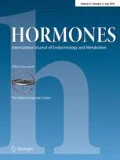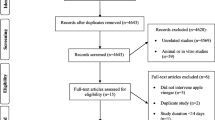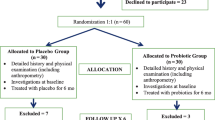Abstract
Purpose
Oxidative stress is closely related to type 1 diabetes mellitus (T1DM), playing a key role in the pathogenesis of the disease and progression of complications. It is characterized by loss of equilibrium between oxidative factors and antioxidant protective mechanisms. Several markers have been used to assess both components of oxidative status; two of which are malondialdehyde (MDA) and ferric reducing antioxidant power (FRAP).
Methods
We investigated glycated hemoglobin (HbA1c), lipid profile, MDA, and FRAP in 35 patients with T1DM, aged 2–23 years, at the end of two 4-month observational periods: period A: standard insulin dosing per meal, and period B: proper prandial insulin dosing based on the amount of carbohydrates contained in each meal.
Results
At the end of period B, (i) glucose control (HbA1c) was improved; (ii) oxidative stress, estimated by MDA, showed a tendency to decrease; and (iii) antioxidant capacity, estimated by FRAP, was significantly increased compared with that of period A. No significant differences were observed in the lipid profile of the patients between the two periods.
Conclusion
Proper insulin dosing based on carbohydrate counting (CC) may have an impact on the antioxidant defensive mechanisms of patients with T1DM through the attainment of a better glycemic profile. There are also indications that it may reduce MDA, an important biomarker of oxidative stress and a significant mediator of complications in T1DM. Therefore, prompt dietetic intervention using CC as early as possible after the diagnosis of T1DM is important for achieving optimal glycemic control and improved oxidative status.



Similar content being viewed by others
References
Kawasaki E (2009) Type 1 diabetes and autoimmunity. Clin Pediatr Endocrinol 23:99–105
Asmat U, Abad K, Ismail K (2016) Diabetes mellitus and oxidative stress – a concise review. Saudi Pharm J 24:547–553
Kangralkar VA, Patil SD, Bandivadekar RM (2010) Oxidative stress and diabetes: a review. Int J Pharm Appl:38–45
Lipinski B (2001) Pathophysiology of oxidative stress in diabetes mellitus. J Diabetes Complicat 15:203–210
Powers SK, Nelson WB, Hudson MB (2011) Exercise-induced oxidative stress in humans: cause and consequences. Free Radic Biol Med 51:942–950
Pavlatou MG, Papastamataki M, Apostolakou F, Papassotiriou I, Tentolouris N (2009) FORT and FORD: two simple and rapid assays in the evaluation of oxidative stress in patients with type 2 diabetes mellitus. Metabolism 58:1657–1662
El Faramawy SM, Rizk RA (2011) Spectrophotometric studies on antioxidants-doped liposomes. J Am Sci 7:363–369
Ceriello A (2006) Oxidative stress and diabetes-associated complications. Endocr Pract 12:60–62
Vollaard NBJ, Shearman JP, Cooper CE (2005) Exercise-induced oxidative stress: myths, realities and physiological relevance. Sports Med 35:1045–1062
Bansal AK, Bilaspuri GS (2011) Impacts of oxidative stress and antioxidants on semen functions. Vet Med Int:2010
Droge W (2011) Free radicals in the physiological control of cell function. Physiol Rev 82:47–95
Fridovich I (1999) Fundamental aspects of reactive oxygen species, or what’s the matter with oxygen? Ann N Y Acad Sci 893:13–18
VanderJagt DJ, Harrison JM, Ratliff DM, Hunsaker LA, Vander Jagt DL (2001) Oxidative stress indices in IDDM subjects with and without long-term diabetic complications. Clin Biochem 34:265–270
Golbidi S, Badran M, Laher I (2012) Antioxidant and anti-inflammatory effects of exercise in diabetic patients. Exp Diabetes Res 2012
Maritim AC, Sanders RA, Watkins JB 3rd (2003) Diabetes, oxidative stress, and antioxidants: a review. J Biochem Mol Toxicol 17:24–38
Khanna S (2000) Thiol antioxidants, Ph.D. Dissertation. Department of Physiology University of Kuopio, Kuopio, Finland
Perez-Matute P, Zulet MA, Martinez JA (2009) Reactive species and diabetes: counteracting oxidative stress to improve health. Curr Opin Pharmacol 9:771–779
Esterbauer H, Schaur RJ, Zollner H (1991) Chemistry and biochemistry of 4-hydroxynonenal, malonaldehyde and related aldehydes. Free Radic Biol Med 11:81–128
Benzie IF, Strain JJ (1996) The ferric reducing ability of pasma (FRAP) as a measure of “antioxidant power”: the FRAP assay. Anal Biochem 239:70–76
Tascini G, Berioli MG, Cerquiglini L, Santi E, Mancini G, Rogari F, Toni G, Esposito S (2018) Carbohydrate counting in children and adolescents with type 1 diabetes. Nutrients 10:109
Gillespie SJ, Kulkarni KD, Daly AE (1998) Using carbohydrate counting in diabetes clinical practice. J Am Diet Assoc 98:897–905
Smart CE, Annan F, Higgins LA, Jelleryd E, Lopez M, Acerini CL (2018) ISPAD clinical practice consensus guidelines 2018: nutritional management in children and adolescents with diabetes. Pediatr Diabetes 19:136–154
Papandreou MA, Dimakopoulou A, Linardaki ZI, Cordopatis P, Klimis-Zacas D, Margarity M, Lamari FN (2009) Effect of a polyphenol-rich wild blueberry extract on cognitive performance of mice, brain antioxidant markers and acetylcholinesterase activity. Behav Brain Res 198:352–358
Koutroumani N, Partsalaki I, Lamari F, Dettoraki A, Rojas Gil AP, Karvela A, Kostopoulou E, Spiliotis BE (2013) Protective mechanisms against oxidative stress and angiopathy in young patients with diabetes type 1 (DM1). J Pediatr Endocrinol Metab 26:309–317
Benzie IF, Strain JJ (1999) Ferric reducing/antioxidant power assay: direct measure of total antioxidant activity of biological fluids and modified version for simultaneous measurement of total antioxidant power and ascorbic acid concentration. Methods Enzymol 299:15–27
Somogyi A, Rosta K, Pusztai P, Tulassay Z, Nagy G (2007) Antioxidant measurements. Physiol Meas 28:41–55
Johansen JS, Harris AK, Rychly D, Ergul A (2005) Oxidative stress and the use of antioxidants in diabetes: linking basic science to clinical practice. Cardiovasc Diabetol 4:5. https://doi.org/10.1186/1475-2840-4-5
Lenzen S, Drinkgern J, Tiedge M (1996) Low antioxidant enzyme gene expression in pancreatic islets compared with various other mouse tissues. Free Radic Biol Med 20:463–466
Azevedo-Martins AK, Lortz S, Lenzen S, Curi R, Eizirik DL, Tiedge M (2003) Improvement of the mitochondrial antioxidant defense status prevents cytokine-induced nuclear factor-kappa B activation in insulin-producing cells. Diabetes 52:93–101
West IC (2000) Radicals and oxidative stress in diabetes. Diabet Med 17:171–180
Drews G, Krippeit-Drews P, Dufer M (2010) Oxidative stress and beta-cell dysfunction. Pflugers Arch 460:703–718
American Diabetes Association: nutrition recommendations and interventions for diabetes; a position statement of the American Diabetes Association (2008) Diabetes Care 31:61–78
Firoozrai M, Nourbakhsh M, Razzaghy-Azar M (2007) Erythrocyte susceptibility to oxidative stress and antioxidant status in patients with type 1 diabetes. Diabetes Res Clin Pract 77:427–432
Erciyas F, Taneli F, Arslan B, Uslu Y (2003) Glycemic control, oxidative stress, and lipid profile in children with type 1 diabetes mellitus. Arch Med Res 35:134–140
Vincent HK, Powers SK, Stewart DJ, Shanely RA, Demirel H, Naito H (1999) Obesity is associated with increased myocardial oxidative stress. Int J Obes Relat Metab Disord 23:67–74
Vincent HK, Powers SK, Dirks AJ, Scarpase PJ (2001) Mechanism for obesity-induced increase in myocardial lipid peroxidation. Int J Obes Relat Metab Disord 25:378–388
Author information
Authors and Affiliations
Contributions
Eirini Kostopoulou and Bessie Spiliotis: conceptualization
Fotini Lamari, Spyros Skiadopoulos, Ioanna Partsalaki, and Andrea Paola Rojas Gil: methodology
Eirini Kostopoulou and Bessie Spiliotis: formal analysis and investigation
Eirini Kostopoulou: writing—original draft preparation
Bessie Spiliotis, Ioanna Partsalaki, Spyros Skiadopoulos, Fotini Lamari, and Andrea Paola Rojas Gil: writing—review and editing
Bessie Spiliotis: supervision
Corresponding author
Ethics declarations
Conflict of interest
The authors declare that they have no conflict of interest.
Ethical approval
All procedures performed in studies involving human participants were in accordance with the ethical standards of the Committee of Ethics and Code of Conduct for Research of the University Hospital of Patras and with the 1964 Declaration of Helsinki and its later amendments, or comparable ethical standards. No reference number was needed for this specific data collection of the studied patients.
Informed consent
Obtained from the parents of the patients involved and the patients.
Additional information
Publisher’s note
Springer Nature remains neutral with regard to jurisdictional claims in published maps and institutional affiliations.
Rights and permissions
About this article
Cite this article
Kostopoulou, E., Livada, I., Partsalaki, I. et al. The role of carbohydrate counting in glycemic control and oxidative stress in patients with type 1 diabetes mellitus (T1DM). Hormones 19, 433–438 (2020). https://doi.org/10.1007/s42000-020-00189-8
Received:
Accepted:
Published:
Issue Date:
DOI: https://doi.org/10.1007/s42000-020-00189-8




